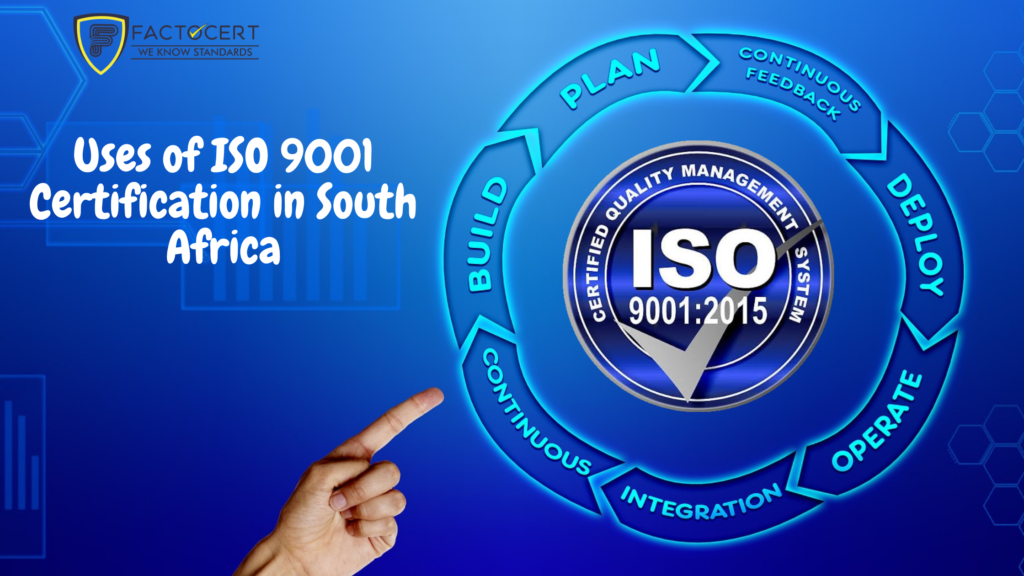Overview of ISO 9001 Certification in South Africa:
ISO 9001 in South Africa specifies the requirement for Quality Management System and it is also called as mother of all standards. All the necessities of ISO 9001 are generic and are meant to apply to any organization, despite its sort or size, or the product and services it provides.
ISO 9001 defines the criteria for a top-quality Management System and is the sole standard within the family that will be audited against it with the goal of voluntary compliance or to become the third party registered. There are over a million firms and organizations in over 170 countries certified to ISO 9001 quality management system.
Quality Objectives – Classifying and tracking Quality Objectives are a requirement of ISO 9001. These Quality Objectives must be recognized and followed at applicable levels, capacities and procedures. Capacities or procedures, where quality objectives are required can be chosen dependent on the nature, size, or criticality of the process.
The Quality Objectives should be following the quality policy and think about all related requirements. Quality Objectives should be measurable, relevant to the products and services being offered, and focus on upgrading client satisfaction.
How to establish and frame Quality Objectives?
Identify significant-quality objectives which are steady to your association’s quality policy is the initial phase in planning your Quality Management System. Targets can be set up through S.M.A.R.T objectives. S.M.A.R.T is an abbreviation utilized as a guide for building up measurable goals, which are Specific, Measurable, Attainable, Relevant, and Time-Oriented. Every objective should be:
Specific – An Objective must be clearly defined or explained so everyone can understand it in the same way.
Measurable – An objective should be measurable and understood in terms of size or degree.
Attainable – An objective set that is beyond the limit or capabilities of the company could never be met. There should be mechanisms accessible or built to measure these objectives and the objectives set should be achievable.
Relevant – The objectives set should be relevant to the organization’s context. An objective should align to Quality Policy and clients or legal or statutory requirements can be guaranteed, with the goal that it is relevant to the strategic direction of the organization.
Time-Oriented – An objective should be time-bound. The system made for estimation of objectives should address when the objective will be evaluated to understand that it is met.
Quality Objectives should be set by a discussion with top management and be relevant to the conformity of products and services offered by the organization. A few examples of quality objectives are:
- Improvement in customer satisfaction evaluations by 3% yearly
- The on-time delivery accomplishment of 99% each quarter
- Improve productivity of the team by 2% yearly
After Quality Objectives are identified, the following stages required for arrangement of these objectives are:
Document Quality Objective: The Quality Objectives need to be documented. You could utilize a Quality Manual anyway this is not, at this point required in the latest version of ISO 9001.
Communicate Quality Objectives: The Quality objectives should be communicated to every single individual or department or division. This might be done through Quality Awareness meetings with all groups.
Establish Mechanisms to capture Quality Objectives: There should be a mechanism set up in the organization to calculate the Quality Objectives. The mechanism prepared should be organized for all departments or divisions and these should be followed on a fixed frequency to guarantee compliance to these goals or objectives.
Review Quality Objectives: Once an organization begins capturing these goals, they need to audit and calculate the performance of these goals or objectives. This should be possible through a Management review meeting which is planned on fixed dates. Considering the outputs of the audits, Quality objectives might be refreshed or updated, as suitable
Plan Corrective Actions: Whenever the Quality Objectives don’t meet the objectives set, there should be corrective actions arranged against them. This offers a chance to distinguish process upgrades that can help improve the performance of the Quality Objectives.
Strengthening and maintaining the performance of Quality Objectives is important to guarantee the effectiveness of the Quality Management System. It offers a chance to the organization to improve its procedures and acquire higher efficiency in their work or systems.





